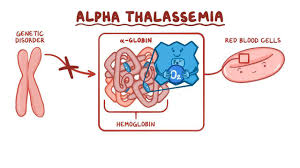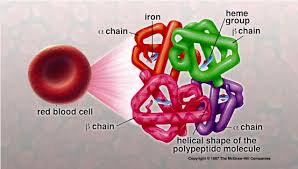Alpha thallasemia
what is Alpha thallasemia?
People who do not produce enough alpha globin protein have alpha Thalassaemia. It is commonly found in Africa, the Middle East India, Southeast Asia, Southern china, and occasionally the Mediterranean region.
Alpha globin is made by four genes, two on each strand of the chromosome 16. Individuals who have one or two abnormal alpha globin genes have alpha Thalassaemia trait.
An individual with alpha Thalassaemia trait defined by the presence of one abnormal alpha globin gene is said to have the silent carrier state. This condition, in which one of the four alpha globin genes is missing or detective, generally causes no health problems because the lack of alpha globin protein is so small that there is no anemia.
It is called “silent carrier” because of how difficult it is to detect. Silent carrier state is “ diagnosed” by deduction when an apparently normal individual has a child with hemoglobin H disease or alpha Thalassaemia minor. It can also be diagnosed by special DNA testing.
An Individual with alpha Thalassaemia trait defined by the presence of two abnormal alpha globin genes is said to have Alpha Thalassaemia Minor.

Here are key points about alpha thalassemia:
Genetic Inheritance: Alpha thalassemia is inherited in an autosomal recessive pattern. This means that a person must inherit two mutated genes (one from each parent) to develop the disorder. The severity of alpha thalassemia depends on how many alpha globin genes are affected.
Types and Severity:
- Silent Carrier: One mutated gene. Individuals are carriers and usually have no symptoms.
- Alpha Thalassemia Trait (Minor): Two mutated genes. Mild anemia may occur but often no treatment is needed.
- Hemoglobin H Disease: Three mutated genes. Moderate to severe anemia and other complications may occur.
- Alpha Thalassemia Major: Four mutated genes. Also known as Hydrops Fetalis, this is usually fatal before birth or shortly after.
Symptoms:
- Silent Carrier and Alpha Thalassemia Trait: Often asymptomatic or mild symptoms such as mild anemia and fatigue.
- Hemoglobin H Disease: More severe anemia, jaundice, enlarged spleen, and sometimes bone changes.
- Alpha Thalassemia Major (Hydrops Fetalis): Severe fetal anemia, edema, and often fatal before or shortly after birth.
Diagnosis: Diagnosis is typically made through blood tests that measure hemoglobin levels and identify abnormal hemoglobin variants. Genetic testing may also be used to confirm the specific type of alpha thalassemia.
Treatment: Treatment depends on the type and severity of alpha thalassemia. Options may include:
- Monitoring and supportive care for silent carriers and alpha thalassemia trait.
- Blood transfusions and folic acid supplementation for hemoglobin H disease.
- In severe cases like alpha thalassemia major (Hydrops Fetalis), prenatal diagnosis and counseling are important. Management may include intrauterine transfusions and supportive care.
Prognosis: The prognosis varies depending on the type and severity of alpha thalassemia. Silent carriers and those with alpha thalassemia trait usually have a normal life expectancy with minimal or no symptoms. The prognosis is poorer for individuals with hemoglobin H disease or alpha thalassemia major, especially if untreated.
Overall, alpha thalassemia is a diverse group of disorders that require careful monitoring and management. Treatment focuses on alleviating symptoms, preventing complications, and improving quality of life for affected individuals.

The Parents’ Association Thalassemic is the national non –profit health organization dedicated to serving patients afflicted with various forms of Thalassaemia most notably the major forms of this generic blood disease

